- Prelude
- Editorial
- Subodh's 'return home'
- A Conversation with TV Santosh
- It's a War Out There
- Raqib Shaw
- Illusions in Red from a very British Indian Sculptor
- Stand Alone: Shibu Natesan
- Reading Atul Dodiya
- Bharti Kher: An Obsession for Bindis
- Bose Krishnamachari
- The Image - Spectacle and the Self
- From Self-depiction to Self-reference: Contemporary Indian Art
- GenNext: The Epitome of New Generation Art
- Kolkata's Contemporary Art A Look in the Mirror
- Innovation Coalesced with Continuing Chinese Qualities
- Kala Bhavana-Charukala Anushad Exchange Program
- Montblanc Fountain Pens
- Dutch Designs: The Queen Anne Style
- Bangalore Dance Beat
- Decade of change
- Distance Between Art & It's Connoisseur
- What Happened and What's Forthcoming
- 3rd India Art Summit
- New Paradigms of the Global Language of Art
- Black Brown & The Blue: Shuvaprasanna
- Art Events Kolkata
- Musings from Chennai
- Art Bengaluru
- Printmaker's Season
- Mumbai Art Sighting
- The Pause of Profound Stillness
- Previews
- In the News
- The Rebel Queen: An icon of her own times yet looked down upon
ART news & views
The Image - Spectacle and the Self
Volume: 3 Issue No: 14 Month: 3 Year: 2011
Overview
by Koeli Mukherjee Ghose
Works of Anju Dodiya, Chintan Upadhyay, Jitish Kallat, Riyas Komu and Sudarshan Shetty
If life and art is to be separated then things surrounding us will never permeate creativity and since the two elements cannot be separated everything flows in to the creative surface, things that are seen, read, heard of and tasted as well as those things that have been dreamt of, not heard of and un-tasted. All of these are materials in the works of Anju Dodiya, Chintan Upadhyay, Jitish Kallat, Riyas Komu and Sudarshan Shetty, living and working in Mumbai, the materials accrued from the self and to an extent an element of selflessness also is then employed to create what appears to be spectacular in their works.
Born in 1964, Anju Dodiya, posits herself as the central character in her watercolours and acrylic works; she claims her own image in a varying range of physical and emotional states, encoding the image with complex juxtapositions of historical references. She employs a range of visual languages i.e. 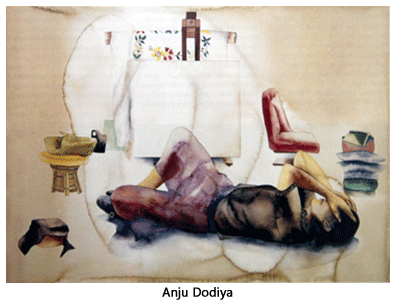 the identifiable characteristic features and rendering mannerisms of paintings from Renaissance Period in the Western Art, Japanese woodcuts and French films. Her recent works are in the medium of watercolours combined with the use of charcoal. She has created works with acrylic on velvet mattresses, rendering her portrait to the image.
the identifiable characteristic features and rendering mannerisms of paintings from Renaissance Period in the Western Art, Japanese woodcuts and French films. Her recent works are in the medium of watercolours combined with the use of charcoal. She has created works with acrylic on velvet mattresses, rendering her portrait to the image.
Anju Dodiya's continuing commitment with the creative process grew to be the central idea in many of her works. In the work titled Fear Frog of 1998, she creates an image identifiable as that of her own, lying tormented on the floor in front of an empty canvas. Adhering to this engagement of creativity and the self, the work titled Entering the Ring reflects her changed mental state as she identifies herself as a Sumo wrestler, ready to let loose her antagonisms on an exposed easel.
Objects such as the easel, brushes, and erasers, seems to propagate a sense of presence of the material means of Anju Dodiya's creative process - in her works, these objects are signifiers of commemoration of a dual hold that of the process of painting, and on the other hand suggests an inquiry of the relevance of such a practice in the present creative engagement with technical processes of the New media, amongst artists of her times.
Analogous to the idea of the artist and the creative engagement, the artist's loss of faith is reflected in the work titled Visitation, 1998, the artist recreates herself in a complex layering of ideas, the image of the protagonist reappears in a tussle with the 'alter ego' discernibly as the guardian angel Gabriel. The easel at the far corner is made to resemble a crucifix, signifying the struggle and the despair in the artistic journey.
Her images call up a strong interplay of reality and illusion with a stylish language of impersonations at work in various levels, be it in preparing an image- character or rendering a period specificity to the image.
Pattern, textures and design elements of the UkiYo e prints, fragments of a Chinese vase reproduced, 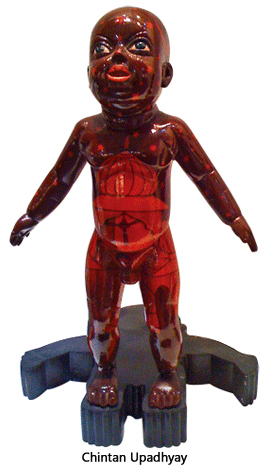 velvet mattresses with designs of art deco origin are summoned to connote aggression, vulnerability and sensuality to the images.
velvet mattresses with designs of art deco origin are summoned to connote aggression, vulnerability and sensuality to the images.
In Her work titled Studio Guest of 1998 the artist creates three magicians as characterizations of herself, the image has a historical reference to that of the 19th century French painting of the Sword Swallowers as the artist is engaged in entertaining the patrons of art visiting the studio, the visitors are depicted in European costumes, the two magicians are shown conjuring tricks while the third one presents an empty surface that should have contained a painting. The image is a strong reaction to a situation of creative subjugation of the artists consequential to the demands posed by International recognition and consumption.
Chintan Upadhyay, was born in 1972 in Partapur in Rajasthan.
The artist has evolved a personalized vision that has gained a position of a consistent conveyor of expression through the infants he creates. These male infants named Chintu by the artist have Indian miniatures painted architectonically on them. The one-foot sculptures, titled Chintu - Nature Gods, have elaborate scenes of nature from the miniature paintings positioned on them, bringing back in context the Karkhana system of working, as practiced by the miniature painters. `
The diminishing precincts of cultures that Chintu embodies, is representational of a condition that generation now is born to an inheritance of a hybrid nature.
The formal conception of Chintu as expressed in paintings and sculptures, highlights an intended perplexity designated to it by the artist, in the process of recognizing the created form Chintu whether a toy? The notion of customizing and influencing natural outcomes lurk heavily around the form. The leitmotif of communication “Chintu” broaches the issue of contamination of ideas and creativity. Chintu is the genie in the hands of his master, his creator Chintan, assigned to voice concerns for female infanticide, the growing disparity between rural and urban existence.
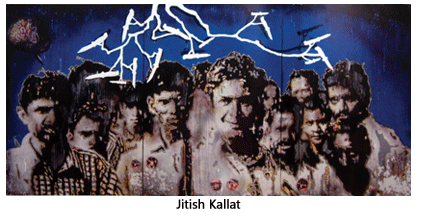 Jitish Kallat was born in 1974, in Mumbai; in his works he deals with the issue of painting in an age that is defined by the mass media. The artist layers his work culling images from newspapers, magazines, advertising billboards, wallpaper and graffiti, his works are opulently supplied with metaphor. He achieved a full overhaul of the painted surface to impersonate the appearance of a television still or a computer monitor, complete with its exterior stations and sensations.
Jitish Kallat was born in 1974, in Mumbai; in his works he deals with the issue of painting in an age that is defined by the mass media. The artist layers his work culling images from newspapers, magazines, advertising billboards, wallpaper and graffiti, his works are opulently supplied with metaphor. He achieved a full overhaul of the painted surface to impersonate the appearance of a television still or a computer monitor, complete with its exterior stations and sensations.
Jitish Kallat's essential premise is the Self Portrait. In his first solo exhibition P.T.O. of 1997, he created paintings of himself in a selection of appearances, encircled by a range of imagery. Copyright registration stamps, inscriptions and titles culminate a hiding and seeking for the narration. The image reference of babies, coffins and the DNA double helix in the paintings induces a sense of an intense vulnerability of an existential nature. The city's lively swarm of people is seen positioned on the precincts of the surface; enacting a consequence of travel, soon after the thronging life is seen to inhabit the centre of the canvas. The painting titled Departure Status-Boarding, 2000, reflects a concern of discrimination, the metro city Mumbai hurls at the daily wage earner, the crouching figure is at once the hero and the prey, the painting personifies the labourer at a train station.
The artist engages in the interplay of text and the image wherein the title and the image permeate each other to break away from playing rigid roles. The painting Ode to a Spinal Cord of 2000 renders the choking sensations of reeling in the crowd daily while moving back and forward in Mumbai. “The spinal cord of the city is its railway line”; this series depicts the idea of an elementary supply of mobility in the lives of people spread out in the expansive city roads and slums.
Groups of people face up to the viewer in paintings titled Spirit Level, 2002 and Italics (War Dance), 2002. Discernible by their deportment these people from the slums are depicted with a metaphor of abstract rendering, a serrated streak of lightning surrounds their presence, network of branches with weapons entangled in them suggestively lead the viewer to sense that crime and violence has pervaded urban life.
The work titled Detergent created in 2004 is based on the speech of Swami Vivekananda on the dangers of religious tenet, the artist created deep inscription using adhesive on acrylic mirror, the work addresses “a new era of initiated violence in the name of religion. The speech that was deliberated at the world Congress of Religions in Chicago on 11 September 1893, Jitish Kallat contrastingly draws reference of the tragedy of the World Trade Centre that occurred 108 years later.
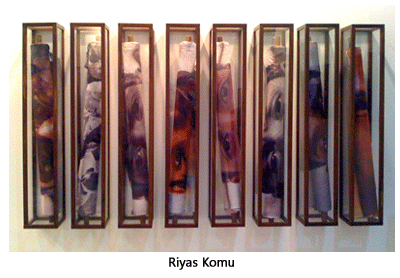 Riyas Komu was born in 1971 in Kerala; he went to Mumbai in 1992 to study literature. Other than sculptures, his artistic opus, straddles different mediums and genres - including photography and video installations. Influenced by his father's political views and his own political ideology and views, his works deliberate political implications. He creates a strong comment based on his experience of the volatile situation of urban Mumbai in his works, expressive of the inconsistency of the urban situation that rides the see-saw of pomp and show on one hand and dismal paucity on the other.
Riyas Komu was born in 1971 in Kerala; he went to Mumbai in 1992 to study literature. Other than sculptures, his artistic opus, straddles different mediums and genres - including photography and video installations. Influenced by his father's political views and his own political ideology and views, his works deliberate political implications. He creates a strong comment based on his experience of the volatile situation of urban Mumbai in his works, expressive of the inconsistency of the urban situation that rides the see-saw of pomp and show on one hand and dismal paucity on the other.
In his series titled Left Legs of 2008 Riyas's absorption with sports and politics is brought to an amalgamation to create a powerful imagery of the athlete's body, that is depicted as the manifestation of pain and loss for every victory and defeat. One from the series of works titled The Iraq Project; the image articulates the power struggle the Iraqi football was caught up in during the time of Saddam Hussein and in the instance of US invasion and occupation of Iraq. A chain of sculptures of a bizarre arrangement of left legs separated from the body, made of concrete, steel, and salvaged teak from Kerala - signifying the place of his origin Riyas effectively recreated lifelike legs of existing football players. The legs bear characteristic features of intricate carvings, rendered with surrealistic details of the anatomy. Sinews, muscles, and ligaments connote the athletic legs; the image puts forth the discrepancy of the valiant against the weak. The artist retains a sense of ambivalence to offer a creative and contemplative space to the viewers.
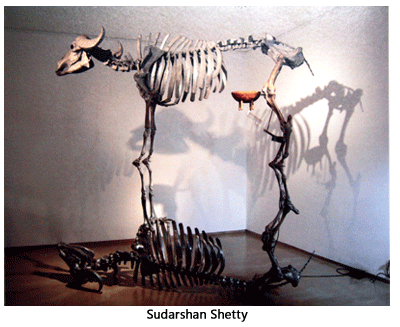 Sudarshan Shetty, was born in 1961, in Mangalore. His large-scale sculptures and installations are distinctive in its sense of poetry and playfulness and a sense of freedom. He presents bits and pieces from everyday life in a captivating recipe of the figurative and the abstract. Revealing diverse aspects of contemporary culture. The artist often draws on simple, subtle distortions of scale in his imagery.
Sudarshan Shetty, was born in 1961, in Mangalore. His large-scale sculptures and installations are distinctive in its sense of poetry and playfulness and a sense of freedom. He presents bits and pieces from everyday life in a captivating recipe of the figurative and the abstract. Revealing diverse aspects of contemporary culture. The artist often draws on simple, subtle distortions of scale in his imagery.
Consecutively breaking away from common practices of image- conception, Sudarshan Shetty puts new ideas at work, challenging customary notions. Shetty has always worked with the notion of boundaries within the personal domain taking along the psychological, social and carnal rudiments. He employs materials of his selection to venerate and characterize such precincts and their foreseeable demise.
Interest for the morbid, the playful, and the seductive characterizes his paintings of the early installations, and recent kinetic sculptural assemblages, lacing his images consistently to evoke emotional responses in his viewers.
The colossal work of 2006 bearing the label Untitled, the artist shows a mechanical sculptural installation that makes the subject of the cow, sentient. The sculpture is made of two life-sized emaciated cows, their hooves placed on top of each other. The sculpture was created in connection with a series of works titled Love-investigating the occurrence of love as 'comical, ironic, and perverse'. In India the idea of the cow is in the fold of the sacred and yet it is a susceptible topic when it is in the domain of difference in belief systems.
The cows bare to the bone, an idea of nakedness created visually by the artist projects a ludicrous act of lovemaking of the bovine skeletons, not in coitus but in the frontal position, as if mimicking the human species. The proximity and movement of the viewer sets off a hammer to strike the udder of one of the cows.
The artists discussed in this treatise are canonical of an instantaneous partisanship that reveals to the viewer a sense of intricate pulsation of the time immediate. While Sudarshan Shetty reveals the artist's pre-concern of human acts being involuntary, thus his work habitually conveys his personal irreverence to recognizable forms of knowledge. Riyas Komu's work echoes with the duality of anticipation and misery and surfaces with the Indian condition in a persistent economic growth and yet India's failure in achieving visibility and significance in the Global context. Jitish Kallat's works brings to the fore his personalized vision of the impact of conurbation on the individual. In Chintan Upadhyay's work the poignant idiom of the infant is the ultimate conveyor of historicity and contemporanaeity. Significant of the fact that Chintu is the offspring of the Contemporary culture that encompasses a miscellany of ideas and practices, that is partly indigenous and partly predisposed to that of the West. Anju Dodiya in her cognizant process of 'self dramatization' reflects upon her imaginative quotient that is constantly at work in her creative yield of self, situations along with an adequate deliverance of drollness.